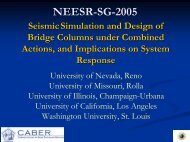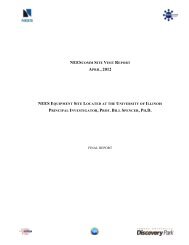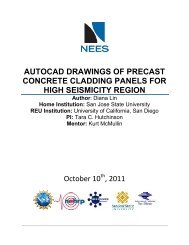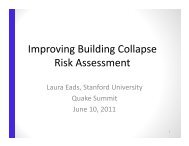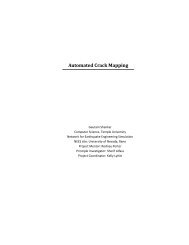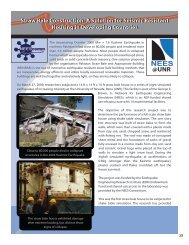PRELIMINARY STUDY OF THE STRONGBACK SYSTEM - PEER ...
PRELIMINARY STUDY OF THE STRONGBACK SYSTEM - PEER ...
PRELIMINARY STUDY OF THE STRONGBACK SYSTEM - PEER ...
Create successful ePaper yourself
Turn your PDF publications into a flip-book with our unique Google optimized e-Paper software.
2.2 Modeling<br />
During analysis, the load combination of interest was 1.2D+1.0EQ. The analysis was performed<br />
in the elastic range of brace response, so in order to simplify the procedure, BRBs were modeled<br />
as solid sections with varying axial areas under the assumption that BRB failure would only be<br />
caused by exceeding the yielding capacity and not by buckling. The conventional braces were<br />
modeled by simply utilizing the pre-existing wide flange sections in SAP2000. SAP2000’s<br />
“Steel Frame Design Check” was used to check failure of conventional braces.<br />
2.3 Loading<br />
Using AISC-360-05, the loading was calculated for this two-story building. Earthquake loading<br />
was determined with equivalent lateral force (ELF) analysis, with seismic base shear from<br />
FEMA-450 provisions equation 5.2-1 equaling 656 kips. This force was rounded and distributed<br />
400 kips at the top floor and 260 kips at the bottom floor. The dead load was calculated based<br />
on loading assumptions from a similar previous test (Lai, 2009) and was applied as a point load<br />
at each of the four column-beam connections. The dead load from member weight was not<br />
accounted for in calculations because the analysis program, SAP2000, was set to account for this<br />
weight during analysis. The braces were arranged in a chevron design and pinned at both ends<br />
with the BRB on the left and the conventional brace on the right (Figure 2.2a). Three different<br />
brace length configurations were considered and given the names 25/75, 50/50, and 75/25 for<br />
reference (Figures 2.2a, 2.2b, 2.2c).<br />
Figure 2.2a: 50/50<br />
Configuration before analysis<br />
with dead load shown<br />
Figure 2.2b: 25/75 configuration<br />
after analysis of right to left<br />
earthquake loading<br />
Figure 2.2c: 75/25 configuration<br />
after analysis of left to right<br />
earthquake loading<br />
6






